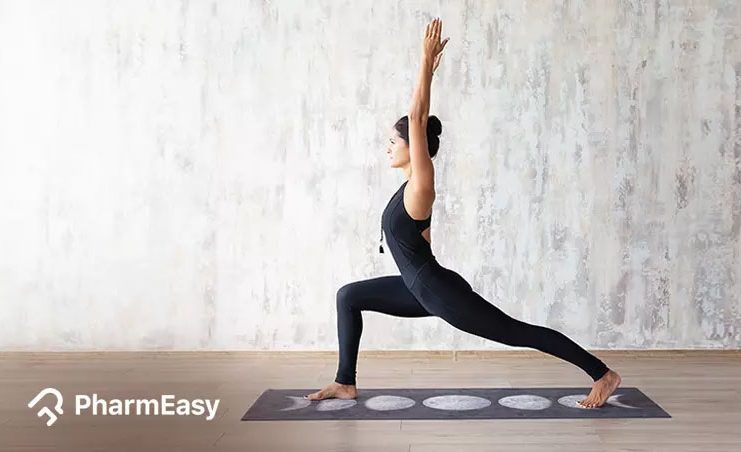Benefits of Virabhadrasana (Warrior Pose) and How to Do It By Dr. Himani Bisht
By Dr. Himani Bisht +2 more

Get,

to manage your symptom
Get your,


4 Cr+ families
benefitted

OTP sent to 9988776655



You’ve successfully subscribed to receive
doctor-approved tips on
Whatsapp

Get ready to feel your best.

Hi There,
Download the PharmEasy App now!!


Register to Avail the Offer
Send OTPBy continuing, you agree with our Privacy Policy and Terms and Conditions

Hi There,
Sign up on PharmEasy now!!
Trusted by 4 crore+ families

OTP sent to 9988776655



You have unlocked 25% off on medicines




Code: NU25
By Dr. Himani Bisht +2 more
Table of Contents
In the current situation, every individual aspires to stay healthy by overcoming physiological and psychological challenges. Yoga has become a popular intervention for the same for all age groups. It has been regarded as a union of mind and soul that brings balance and promote healing of the body. The traditional practice of yoga includes stretching and holding the pose (asanas) for a few seconds along with focusing on breathing. These asanas tone the body and give the mental power for further exercise. One such usual form of yoga asana is Virabhadrasana which provides stamina and balance to the body1,2.,
Virabhadrasana is also known as the warrior pose. The term Virabhadrasana is composed of three words: Vira which means courageous, warrior or vigorous; Badra means auspicious or good, while asana refers to posture. Warrior pose is a standing yoga that provides strength to the shoulders, arms, thighs, and muscles of the back4.

Did You Know?
Depending on the alignment of the body virabhadrasana is categorized into three types1 namely, Virabhadrasana I, Virabhadrasana II, and Virabhadrasana III.
Based on my experience, I highly recommend incorporating Virabhadrasana into your daily routine. Not just for desk jobs, it is proven highly beneficial for athletes involved in gymnastics, archery and shooting. The warrior poses, Virabhadrasana serve to help you achieve equilibrium. Additionally, yoga helps retain the core strength and alignment needed for gymnastics, archery, and shooting3.
Dr. Siddharth Gupta, B.A.M.S, M.D (Ayu)
Virabhadrasana should be performed with proper techniques in the presence of a yoga trainer to avoid discomfort and pressure. Some of the preparatory poses for virabhadrasana are Gomukhasana (cow face yoga), Adho Mukha Savasana (Downward dog pose), Virasana (Hero pose), Trikonasana (Triangle pose), Padottanasana (Wide stance forward pose), Supta virasana (Front opening pose), Vrksasana (Tree pose), Supta Baddha konasana (Butterfly pose), Supta padangusthasana (Reclining head to big toe pose)4.
The steps to practice Virabhadrasana I are:
I read research suggesting the practice of Virabhadrasana may be an excellent weapon against hypothyroidism. Regularly practising this warrior pose may provide several benefits for hypothyroid patients, such as reducing anxiety and inspiring confidence and willpower8.
Dr. Rajeev Singh, BAMS
Virabhadrasana exhibit several health benefits:
Bukowski et al., 2007 conducted a study7 on humans and was approved by the review board of Richard Stockton college of new jersey, USA. The yoga session consists of 14 asanas including virabhadrasana performed for 5 min for six weeks. The result suggested an improvement in the strength and flexibility of the patients suffering from osteoarthritis when compared to the patients in the no-exercise group. The patients with no exercise demonstrated no changes or decreases in pain and function. Therefore, Virabhadrasana may benefit patients suffering from osteoarthiritis1.
Virabhadrasana may also help people having musculoskeletal problems. A weak hamstring can cause repeated injuries or strain in the hamstring and may stiffen the lower back. Virabhadrasana III may help in strengthening the back, calves, hamstrings, and shoulders along with toning abdominal muscles, which may help in dealing with musculoskeletal-related problems. Virabhadrasana I may help patients with Chondromalacia patellae (a condition that leads to softening or breakdown of cartilage under the kneecap) by strengthening the muscles forming the quadriceps (vastus medialis)1.
Virabhadrasana may exert pressure on the abdominal muscles which gives more energy to raise the rib and may help singers. This pressure may also expand the superior and largest muscle in the chest wall (pectoralis major and pectoralis minor which are located below the pectoralis major). This expansion is experienced when arms are raised towards the sky or out sideways allowing a new breath that may help new singers to sing long phrases without collapsing their breath5.
A study6 evaluated the changes in the physiological responses of the human body while performing virabhadrasana. These physiological responses include heart rate, oxygen uptake and blood pressure. A significant rise may observe in the physiological response of the individuals performing Virabhadrasana. This study suggested that virabhadrasana may be beneficial to patients suffering from low blood pressure.
However, more research is required to prove these claims.
Yoga practice may help develop the mind and body; however, it is still not an alternative to modern medicine. You must not rely on yoga alone to treat any condition. Please consult a qualified doctor who will be able to assess your condition correctly and advise accordingly. Moreover, it is necessary to practice and learn yoga under the supervision of a trained yoga teacher to avoid any injuries.
Also Read: Benefits of Tadasana (Mountain Pose) and How to Do It By Dr. Himani Bisht
Virabhadrasana should be performed in presence of a trained yoga practitioner. Some of the contraindications related to Virabhadrasana are4
Also Read: Benefits of Sirsasana (Headstand) and How to Do it By Dr. Ankit Sankhe
Yoga offers various benefits in strengthening and functioning the body as an alternative to standard exercises. Virabhadrasana and its types can be considered by clinicians as an effective modality for improving mental and emotional health and decreasing exhaustion and stress levels.
Also Read: Benefits of Jalneti and How to Do It By Dr. Ankit Sankhe
Virabhadrasana is made of three words: Vira which means warrior; Badra means auspicious or good, while asana refers to posture. Therefore, this asana is also known as the warrior pose4.
Virabhadrasana may help in strengthening the arms, shoulders, and thighs. It may also help in relieving sciatica and maintaining the balance of the body. It may also help singers by opening the chest and enabling them to sing long phrases in one breath4,5.
People suffering from spinal-related disorders, heart disease, increased blood pressure, knees problem like arthritis and cervical issues should avoid the warrior pose4.
Virabhadrasana can be performed by a pregnant lady only if she is a regular yoga practitioner4.
warrior pose is categorised into three types namely, Virabhadrasana I or warrior pose I, Virabhadrasana II or warrior pose II, and Virabhadrasana III or warrior pose III1.
Disclaimer: The information provided here is for educational/awareness purposes only and is not intended to be a substitute for medical treatment by a healthcare professional and should not be relied upon to diagnose or treat any medical condition. The reader should consult a registered medical practitioner to determine the appropriateness of the information and before consuming any medication. PharmEasy does not provide any guarantee or warranty (express or implied) regarding the accuracy, adequacy, completeness, legality, reliability or usefulness of the information; and disclaims any liability arising thereof.
Comments

Leave your comment...
You may also like
Comments